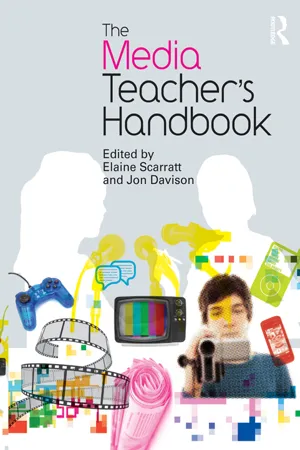
- 260 pages
- English
- ePUB (mobile friendly)
- Available on iOS & Android
The Media Teacher's Handbook
About this book
The Media Teacher's Handbook is an indispensible guide for all teachers, both specialist and non-specialist, delivering Media Studies and media education in secondary schools and colleges.
It is the first text to draw together the three key elements of secondary sector teaching in relation to media study - the theoretical, the practical and the professional - in order to support media teachers throughout their careers:
- Section One: Contexts explores the history of, rationale for, and justification of studying the media from 1900 to the present day, and considers the tensions implicit in the subject caused by opposing views of culture.
- Section Two: Curriculum comprises seven chapters that focus on studying the media from Key Stages 3 and 4 in English, through GCSE and A Level Media Studies. It also explores approaches to teaching the Creative and Media Diploma, media and citizenship, and practical media production.
- Section Three: Career Development is designed to support those establishing and leading Media Studies departments and those who are charged with the initial preparation and professional development of teachers.
Written by experts involved in the teaching, training and examination of Media Studies, this one-stop resource is packed with illustrative case studies and exemplar schemes of work which can be easily adapted for your own needs. Suggested Reading and Recommended Resources sections at the end of each chapter list additional books, films, DVDs, groups, agencies, organisations, contact details, websites and other materials which will support your teaching even further.
The Media Teacher's Handbook is an essential guide to the theory, pedagogy, and practice of media education that will enable you to teach your subject expertly and with confidence.
Frequently asked questions
- Essential is ideal for learners and professionals who enjoy exploring a wide range of subjects. Access the Essential Library with 800,000+ trusted titles and best-sellers across business, personal growth, and the humanities. Includes unlimited reading time and Standard Read Aloud voice.
- Complete: Perfect for advanced learners and researchers needing full, unrestricted access. Unlock 1.4M+ books across hundreds of subjects, including academic and specialized titles. The Complete Plan also includes advanced features like Premium Read Aloud and Research Assistant.
Please note we cannot support devices running on iOS 13 and Android 7 or earlier. Learn more about using the app.
Information
- It is underpinned formally for the first time by a series of four key concepts: Competence, Creativity, Cultural Understanding and Critical Understanding. Interestingly these concepts have for some time circulated, although in a different combination, within media education; indeed, Film Education’s annual conference is entitled ‘CP3: Critical Practice, Creative Process, Cultural Perspectives’. While they are framed rhetorically rather than practically, there is no doubt that their openness and flexibility invite a broader definition of appropriate study texts, and a more inclusive approach to the development of literacy skills.
- There has been a loosening of the structural prescriptions and at times mechanistic micro-objectives of the Literacy Framework, which if followed to the letter exercised a disproportionate impact on teaching and learning, and were considered by many to be inimical to media education.
- This strongly skills-based curriculum has formally acknowledged the range of literacy skills required for citizens of the twenty-first century in its many references to ‘multimodal’ texts. A somewhat uninspiring term – why not simply ‘media’? – multimodality can however become the semantic loophole through which, for example, to develop Speaking and Listening. A popular TV show can be legitimately discussed as a multi-platform vehicle, on screen, online, through press coverage, SMS and on social network sites; under the Reading strand a Shakespeare play can be analysed in a variety of formats and media, from page to stage to heritage movie to classic TV serial to graphic novel to remake to TV ad and beyond. These are not new examples, neither are they assessment-proof; inevitably multimodal study will be assessed in terms of the three conventional English strands, and the media learning will be evaluated only in terms of students’ communication skills. But they are a start.
- The Revised PoS and their interpretation by the Awarding Bodies for the English GCSE 2010 specifications suggest a new commitment to offering students a wider range of creative and analytic opportunities for learning with and through media. There is active encouragement for the use of multimodal adaptations, the use of moving image media as stimulus for talk and creative writing, and for the study of spoken language. The challenge for media education is, as it always has been, to find ways of exploiting these activities so that media texts are not merely transparent vehicles for skills development, but are in themselves objects of investigation and analysis, and situated in a broader cultural context.
- The revised curriculum reinforces individual subject disciplines with a number of over-arching cross-curricular ‘dimensions’, of which, significantly, technology and the Media is one. The aim is to provide opportunities across the curriculum for students to ‘consider media as both consumers and authors of content’, to engage with critical questions about the reliability of online content, and to acquire digital communication skills. Despite a skills-based agenda more closely identified with ICT than with media education, and a focus on access and competence rather than critical and political enquiry, this dimension offers further opportunities to find ways of integrating the study of media into a wider range of subject areas, and in theory at least opens the door to new forms of inter-disciplinary collaboration.
Table of contents
- Cover
- Half Title
- Title Page
- Copyright
- Contents
- List of illustrations
- Notes on contributors
- Introduction
- Section One: Contexts
- Section Two: Curriculum
- Section Three: Career development
- Bibliography
- Index